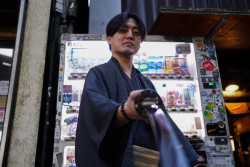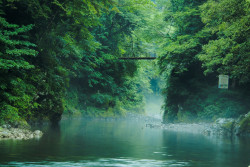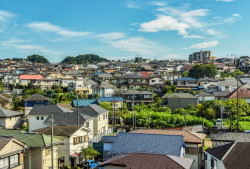
January 20, 2012
Building the Future
A preview of Tokyo’s architectural skyline in 2012
By Metropolis
Originally published on metropolis.co.jp on January 2012


Tokyo’s architectural landscape is a constantly changing scene. Don’t like a building in Tokyo? Wait five minutes and the scaffolding crews will arrive, take it down and presto, before you know it—new building. With this etch-a-sketch-like approach to planning, Tokyo is one of the most exciting urban landscapes on the planet. If you turn a blind eye to the consequent construction waste, high carbon footprint, etc.—and despite the uncertain economic times—you can look forward to an architecturally exciting 2012 in Tokyo.
The city has always loved big architectural gestures and the biggest of 2012 will surely be the 634-meter Sky Tree (www.tokyo-skytree.jp/english). Slated to officially open on May 22, it is already the world’s tallest free-standing tower—topping the former number one, China’s Guangzhou Tower, by 34 meters. Intriguingly, the cutting-edge technology employed in the Sky Tree was inspired by traditional multistoried pagoda that employ shimbashira-seishin, or “central-column vibration control.”
Meanwhile, more vertical thrills are to be had at the 182.5-meter Shibuya Hikarie (www.hikarie.jp), opening on April 26. Its 34 glass-clad floors filled with youth-oriented shops, offices, a theater and exhibit hall, will be Shibuya’s answer to Laforet Harajuku and a stern test for the 109 emporium.
Both of these projects show the genius (and daring) of structural engineering in tremor-prone Japan as well as the love for all things, well… big. Yet in terms of design, they are somewhat generic and raise questions about the need for yet another bland commercial tower in Tokyo.
However, the mood in the Year of the Dragon looks to be moving towards a subtler design aesthetic in public buildings, reflecting a growing consideration of the environment, both manmade and natural. With reconstruction in Tohoku only beginning, the desire to find innovative, sustainable ways of building is growing. Several new projects seek not only to fit into, but also enhance their surroundings.
With the rise of the Sky Tree, the Asakusa area has seen a spate of new architectural projects. One of the most exciting is the Asakusa Culture and Tourist Center, by Kengo Kuma (www.kkaa.co.jp), which promises to make an elegant contemporary counterpart to its historic neighbor, the temple complex of Sensoji. Presently under construction opposite the iconic Kaminari-mon Gate, Kuma’s design resembles a delicate house of cards, with one glass and wooden lattice structure atop another. It will house a tourist information center as well as a community hall, exhibition space and cafeteria, which will all offer spectacular views of the ancient temple’s swooping roofs.
The much-awaited Daikanyama T-Site (http://tsite.jp/daikanyama), designed for Tsutaya by Klein Dytham Architects (www.klein-dytham.com), opened in early December to general delight and is drawing even more urban cool hunters to one of Tokyo’s most stylish neighborhoods. Covering a 12,000m2 site, the attractive low-rise complex of shops, eateries and an art gallery is organized around a public green space with old-growth trees. Three distinctive T-covered buildings house a huge, browser-friendly Tsutaya. The buildings are linked by overhead walkways and, on the ground level, by a “magazine avenue”—a wooden path through the three buildings where you can find every local and international magazine imaginable. One upper floor is devoted to a chic cafe and lounge space lit by a large skylight and open until 2am. The larger complex even has a dog-grooming salon with a sawdust-covered “dog-garden” where newly coiffed pets frolic beneath a giant canine sculpture. Overall, it is a welcoming space that successfully blends well-designed architecture, greenery, and places for people to shop, eat, socialize or work. It is a new kind of complex for Tokyo—on a smaller, human-sized scale, design-oriented with a restrained, green aesthetic. Considering the numbers of black-clad young architects strolling around the site, camera in hand, at its opening, it will no doubt prove a template for future projects.
More experiments in urban planning are now underway in Fujisawa City on the southwest outskirts of Tokyo, where Panasonic and other Japanese companies are building an energy-efficient “smart town.” Fujisawa Sustainable Smart Town, or Fujisawa SST for short, aims to be a model for sustainable living (http://meturl.com/fsst). And at a projected cost of ¥60 billion, it better be.
The project began in 2009 but has taken on new impetus since March as setsuden concerns became daily conversation. Being built on the site of an old Panasonic factory, the town is designed with an intelligent network of electricity grids that will permit energy conservation, sharing and storage. There will be a system of electric-car sharing, solar panels, LED lights and smart appliances, which will communicate with a main network in order to conserve energy. Passive energy sources will also be tapped with “wind paths” and strategically placed greenery. When complete in 2014, it will support 1,000 households for approximately 3,000 people and should, according to Panasonic, reduce normal carbon emissions by 70%. Other companies are also proposing similar ideas in Saitama, Yokohama and elsewhere, so watch out for a new “smart town” near you.
The growing interest in green architecture takes a literal turn in several individual projects. The busy and much-loved Azabu Juban shotengai often sees buildings come and go as businesses look to attract customers with fresh designs. Among the latest crop is an elegant plant-clad project by Edward Suzuki Architects (www.edward.net). Called the Vent Vert, or “Green Wind,” its nine-storey facade will be covered by live greenery which, when completed in the spring 2012, will give both tenants and passersby the visual and tactile pleasures of a vertical garden on a dense city street.

Hiroshi Nakamura and NAP Architect’s Tokyu Plaza Harajuku Omotesando (http://meturl.com/tokyuplaza) will even attempt a small forest. Opening in April, the shopping complex will feature a roof like a bouquet of trees, a symbolic nod to the famous zelkova trees of Omotesando Dori and inserting an ecological note into a glamorous consumerist boulevard. Already, treetops can be seen peeking out behind the construction site’s fences.
Omotesando is a constantly changing showplace for new architecture, even at the cost of the loss of older buildings by major architects. Pritzker Prize-winning architect Kenzo Tange’s 1977 Aoyama Obayashi Building (better known as the Hanae Mori Building) on Omotesando was recently demolished despite protests, to make way for a new construction. Considering that the average lifespan of a building in Tokyo is about 20 years, Tange’s building was practically ancient at 33. But Tokyo’s astronomical land prices mean that older buildings are rarely renovated, even one by such an iconic architect like Tange. Instead they are demolished and replaced by larger, more profitable buildings. The structure now being built (by Obayashi Corporation, builders of the Sky Tree) will reach the maximum height allowable on the street rising, 48 meters with nine stories (compared to Tange’s five) and add some 5,000m2 of profitable retail space. It will be interesting to see, when the scaffolding comes down, how this new building compares to a work by the modern master.

However, not all old buildings are just for tearing down. Tokyo’s long preferred scrap-and-rebuild method of urban renewal is starting to be questioned. Economic uncertainty as well as issues of recycling, building waste and preservation are helping to start a new trend: renovations of historic buildings. The 1914 Tokyo Station has been receiving a major facelift for several years. But the construction wrapping will come off this year. Topped by shiny new copper roofs, the brick complex will return a bit of refurbished Meiji/Taisho-Era charm to the crisp business district of Marunouchi and hopefully add a bit of pleasure and convenience for train and metro users, who have long skirted around the huge construction site. The exterior should be fully revealed in March and services at the station could start as early as June.
All these trends—to more ecologically minded buildings, more user-friendly public spaces, more renovations of older buildings—have been growing in recent years. But since the March earthquake and tsunami, architects and others are seriously reflecting on where Japanese architecture goes next.
Look out for the above projects as well as for avant-garde works by smaller, up-and-coming firms in Japan, such as Tezuka Architects (www.tezuka-arch.com), Sou Fujimoto Architects (www.sou-fujimoto.net) and Kumiko Inui (www.inuiuni.com).







